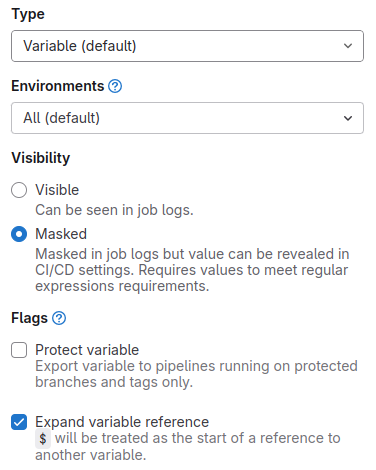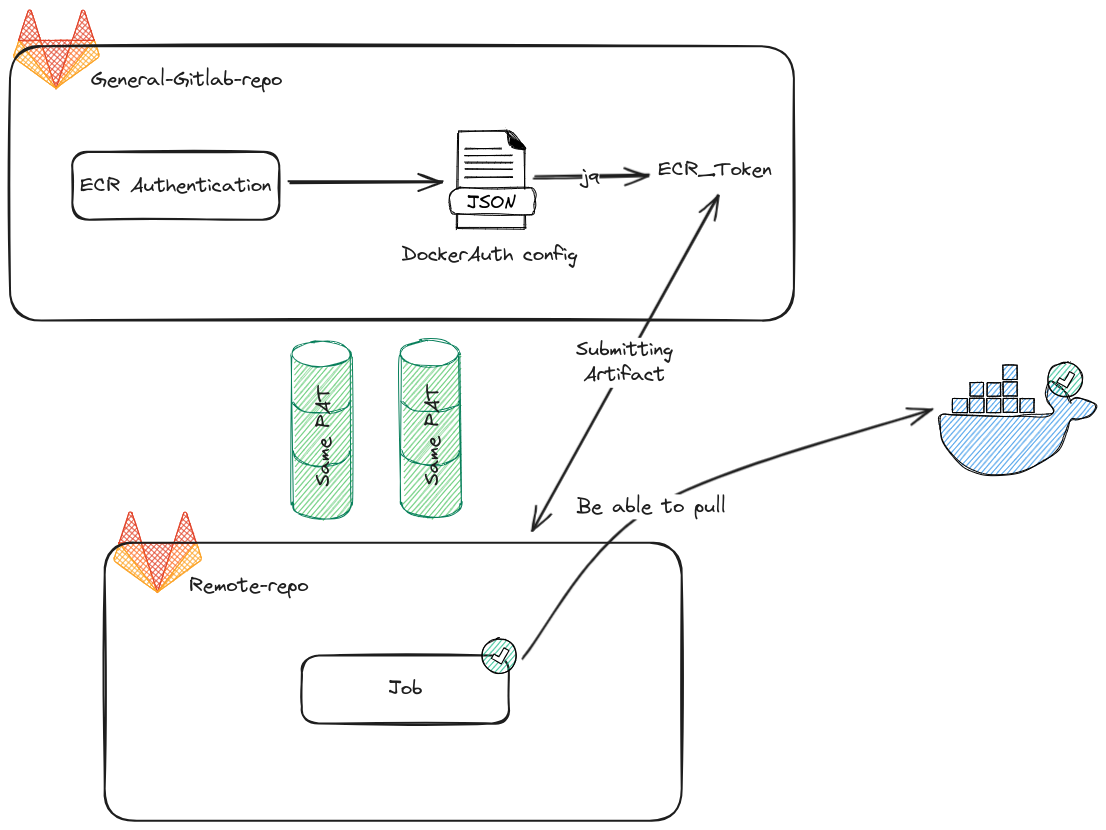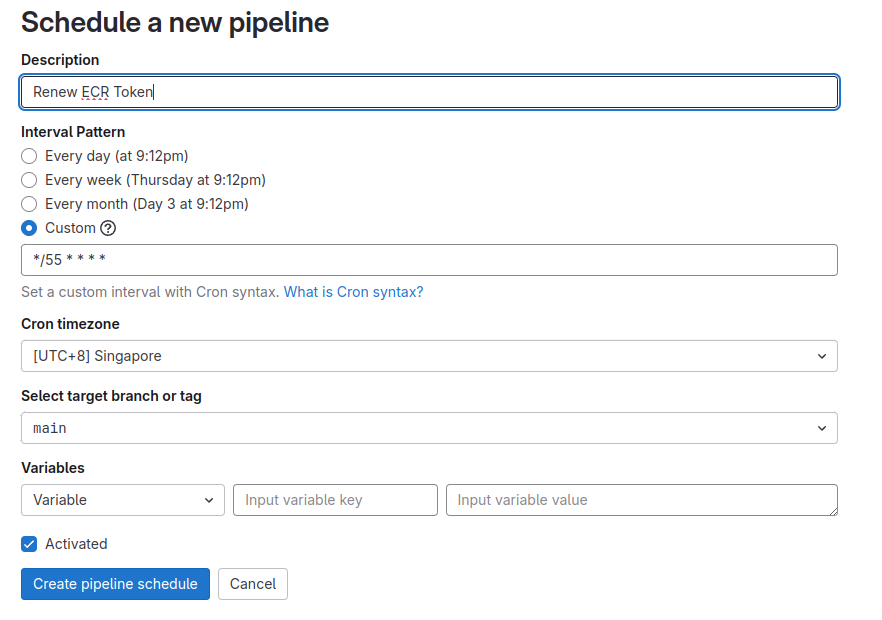Introduce GitlabCI
Abstract
This template which store short
yamlto show how can work withGitlabCIand note some specify for use case
More information about Gitlab CI/CD and Variables. Go check
General
- Gitlab Documentation - General Documentation about Gitlab
- GitLab Runner - Information about Gitlab Runner and configuration
- GitLab CI/CD examples - GitlabCI/CD Collections
- Gitlab Permissions and roles - About Role and Permissions of account in GitLab organization
Syntax
- Gitlab CI/CD Syntax - Introduce about Gitlab Syntax and usage
- Variables & Predefine variables - GitlabCI Variables and Predefine variables
- Scripts and job logs - Use for format script and log inside job
Features
- GitlabCI Services - Use service keyword GitlabCI
- Run your CI/CD jobs in Docker containers - Setup GitlabCI in docker+machine
- Use Docker to build Docker images - Run Dind to build image inside GitlabCI
- DRY development: A cheatsheet on reusability throughout GitLab - DRY Mindset
- Optimize GitLab CI/CD configuration files - Optimize and DRY Mindset
- CI/CD components - GitlabCI Components
- Downstream pipelines - Use Downstream pipelines for trigger
- Gitlab CI/CD Pass artifacts/variables between pipelines - Methodology for resue artifacts
- GitLab CI/CD artifacts reports types - Report type of Gitlab Artifact
- GitLab CI/CD Environments and deployments - Environments describe where code is deployed.
- GitLab container registry - You can use the integrated container registry to store container images for each GitLab project.
- How to modify a variable, used as name for docker image - Dynamic image to using for gitlabci
Issues
Use cases and scenarios
Case 1: Completely pipeline for Container Services
Info
React build app, test and build Image for container services
Info
This pipeline definition will cover for me and you with mostly cases when you work with GitlabCI
- Run Script
- Perform test
- Build code and upload artifact
- Build docker image and push to currently registry
# Define stage for running job inside
stages:
- 'synchronize-code'
- 'test'
- 'build-code'
- 'build-image'
# Choose the default image if not set, it will use it
default:
image:
name: node:18-bullseye
# Default, run script before you run the script on job
before_script:
- npm i -g yarn --force
- yarn install
# Job is define with rule, another before_script and script
synchronize-code-job:
stage: synchronize-code
retry: 1
rules:
- if: '$CI_COMMIT_BRANCH == "main"'
changes:
- src/config/i18n/data/*
image: debian:11.7
before_script:
- apt update && apt install -y curl jq
script:
- bash -c "./utils/synchronize_gitlab.sh $(echo $PRIVATE_GLAB_TOKEN) $(echo $GLAB_USERNAME)"
test-code-job:
stage: test
retry: 1
script:
- yarn lint:fix
allow_failure: false
build-code-job:
stage: build-code
retry: 1
script:
- yarn build
- cp -a dist/. public/
# Upload artifact to gitlab, on path and keep on time
artifacts:
untracked: false
when: on_success
expire_in: "30 days"
paths:
- "./public"
allow_failure: false
# For some reason, Docker in Docker was tough suggestion with need to manipulated agent run. So alternative for that is using kaniko
# Read on: https://docs.gitlab.com/ee/ci/docker/using_kaniko.html
build-image-job:
stage: build-image
retry: 1
image:
name: gcr.io/kaniko-project/executor:debug
entrypoint: ['']
rules:
- if: '$CI_COMMIT_BRANCH == "main"'
variables:
IMAGE_NAME: '$CI_REGISTRY_IMAGE:$CI_COMMIT_BRANCH'
before_script: # Login into registry to push image
- mkdir -p /kaniko/.docker
- echo "{\"auths\":{\"${CI_REGISTRY}\":{\"auth\":\"$(printf "%s:%s" "${CI_REGISTRY_USER}" "${CI_REGISTRY_PASSWORD}" | base64 | tr -d '\n')\"}}}" > /kaniko/.docker/config.json
script:
- /kaniko/executor
--context "${CI_PROJECT_DIR}"
--dockerfile "${CI_PROJECT_DIR}/Dockerfile"
--destination "${CI_REGISTRY_IMAGE}:${CI_COMMIT_SHORT_SHA}"
after_script:
- rm -rf /kaniko/.docker
allow_failure: falseCase 2: Build & push docker image to private registry
Info
Use private ECR of AWS with dind (Local Include)
Before run and execute the script, you need to expose some variables into CI/CD variables because of AWS authentication, and one more to ensure anything secrets will not expose
- AWS_ACCESS_KEY_ID
- AWS_SECRET_ACCESS_KEY
- AWS_ACCOUNT
Remember when you want to your variables have effected with your .gitlab-ci.yml pipelines, you need to concern about use variables in mode protected or not because if your branch is not protected, you variables will not have export anything, that sick 😄

And then you can execute pipelines like usual, but for become special, I will use add on include keyword to import somewhere template gitlab, and try to use this one via !reference
You need to create template in your repo, for example /templates/ci/ecr-auth.gitlab-ci.yml
.ecr_auth:
before_script:
- export AWS_ACCESS_KEY_ID=$AWS_ACCESS_KEY_ID
- export AWS_SECRET_ACCESS_KEY=$AWS_SECRET_ACCESS_KEY
- export AWS_ACCOUNT=$AWS_ACCOUNT
- apk add aws-cli
- aws ecr get-login-password --region $AWS_DEFAULT_REGION | docker login --username AWS --password-stdin $AWS_ACCOUNT.dkr.ecr.$AWS_DEFAULT_REGION.amazonaws.comInfo
With template will help us to authentication AWS Account, we will use that via
!referncetags inside your.gitlab-ci.ymland attach with template define with name and which one to use inside template. For example, I have.ecr_authtemplate withbefore_script, base on those one you can use with!reference [.ecr_auth, before_script]
And to use !reference in yaml file of editor, you need to configure inside settings of them for bypass the error
{
"yaml.customTags": [
"!reference sequence"
]
}Info
YAML has a feature called ‘anchors’ that you can use to duplicate content across your document. For example, read here: YAML anchors for scripts
Warning
But You can’t use YAML anchors across multiple files when using the
includekeyword. Anchors are only valid in the file they were defined in. To reuse configuration from different YAML files, use!referencetags or theextendskeyword.
stages:
- "build-docker-image"
include:
- local: "/templates/ci/ecr-auth.gitlab-ci.yml"
image: docker:27
# Remember if you use docker:dind from another registry, set alias for service to prevent the error
# Documentation: https://docs.gitlab.com/ee/ci/services/#available-settings-for-services
services:
- docker:dind
before_script:
- !reference [.ecr_auth, before_script]
build-python-image:
stage: build-docker-image
when: manual
script: |
docker build -t $AWS_ACCOUNT.dkr.ecr.$AWS_DEFAULT_REGION.amazonaws.com/base-image:python-generic -f ./docker/python/Dockerfile .
docker push $AWS_ACCOUNT.dkr.ecr.$AWS_DEFAULT_REGION.amazonaws.com/base-image:python-generic
allow_failure: false
build-node-image:
stage: build-docker-image
when: manual
image:
name: docker:dind
script: |
docker build -t $AWS_ACCOUNT.dkr.ecr.$AWS_DEFAULT_REGION.amazonaws.com/base-image:node-generic -f ./docker/node/Dockerfile .
docker push $AWS_ACCOUNT.dkr.ecr.$AWS_DEFAULT_REGION.amazonaws.com/base-image:node-generic
allow_failure: falseCase 3: Authentication Job with private ECR from remote repository

Info
Purpose: Create a general template, that help job can authenticate to private ECR from remote repo, following that job will pull and use private docker image for jobs instead of use the public version
Following this idea, Gitlab offers for us one methodology to help us authentication private CR via CI/CD variables by DOCKER_AUTH_CONFIG. Read more at documentation
Note
Remember, DOCKER_AUTH_CONFIG will only help you authenticate your service for pull image from docker registry, If you want to make interaction with private registry, please use
docker loginorcrane auth login
-
Create a CI/CD variable
DOCKER_AUTH_CONFIGwith the content of the Docker https://docs.gitlab.com/ee/ci/yaml/script.html#multiline-commands-not-preserved-by-folded-yaml-multiline-block-scalarconfiguration file as the value- For protected, general repository will use and wrap authentication, such as
AWS_ACCESS_KEY_IDandAWS_SECRET_ACCESS_KEY, we only authenticate privateECRvia only general repository. - Therefore, we will use
downstreamtechniques ofGitlab, with one help us trigger general pipeline from remote repository, and in the last that will submit authentication successfully as~/.docker/config.jsonto remote repository
- For protected, general repository will use and wrap authentication, such as
-
You can now use any private image from private ECR defined in
imageorservicesin your.gitlab-ci.ymlfile
Create Upstream Pipeline
Upstream pipeline where we configure to generate token of ECR or private dockerhub, you can do same with each others
stages:
- "build-docker-image"
include:
- local: "/templates/ci/ecr-auth.gitlab-ci.yml"
image: docker:27
services:
- docker:dind
before_script:
- !reference [.ecr_auth, before_script]
after_script: docker logout $AWS_ACCOUNT.dkr.ecr.$AWS_DEFAULT_REGION.amazonaws.com
# Export ECR_AUTH_CONFIG for remote repository
ecr_auth:
stage: .pre
image: docker:27
services:
- docker:dind
when: always
script:
- apk add jq
- echo "AUTH_CONFIG=$(cat /root/.docker/config.json | jq -r ".auths.\"private.container.registry.com\".auth")" >> auth.env
rules:
- when: on_success
artifacts:
reports:
dotenv: auth.env- Follow the technique in the second part, you can reuse template for login
ECR, and try to import that withincludeand!referencekeyword - After run,
before script, It mean yourdocker+machinerunner work and authenticate toprivateECR, now we addjqfor help us manipulate and analysisjsonfile, which one format of/root/.docker/config.jsonand help you retrieve the token when you usedocker logincommand (NOTE: Base64 is actually work and you not need to do anything). - After analysis and retrieve the token, Gilab offer us the methodology to export that result into
.envbecause file is tough for process,therefore with simple string we have easily ways to apply that in other repository. Read more at GitLab CI/CD artifacts reports types
Warning
Remember expose
rulesfor any situation becauseneedortriggerwill base on that for condition which execute command in remote repository
- Lastly, we expose that via artifacts, and you will create downstream pipeline which one retrieve that value
But wait, you need do one more thing. Because of expiration of AWS ECR, you need have strategy to renew that. You don’t have much time to prepare what time we need to trigger pipeline again. That why we need schedule to handle, and Gitlab provide it for us inside crontab and very easily. Read more at Scheduled pipelines

For example, I create pipeline schedule with strategy
- Rerun after every 55 minutes, practice with cron guru
- Select time zone, for example Singapore but it not important in situation
- Select branch, I choose
mainbranch - You can add more custom
variablewhen run pipeline - Click create and enjoy
Create Downstream pipeline
With downstream pipeline you have two option
- Use
triggerto call remote repository, but that tough and to control - Use
needto receive artifact from remote repository
Follow we will use need to define downstream pipeline, for easily expose your token. You will need to practice with curl command with GitlabAPI Project-level CI/CD variables API
# Downstream use need to receive artiface type
stages:
- auth
- ci-stuff
authentication:
stage: auth
image: alpine:3 # recommend for cut of time
needs:
- project: "gitlab/upstream/project"
job: private_auth # same name with job expose token
ref: "main" # branch you want to receive the artifact
artifacts: true
script:
- apk add curl jq
- DOCKER_AUTH_CONFIG=$(echo "{\"auths\":{\"private.container.registry.com\":{\"auth\":\"$(printf "%s" "$AUTH_CONFIG")\"}}}")
- 'UPDATE_CONDITION=$(curl -XGET --header "PRIVATE-TOKEN: $GITLAB_AUTH_TOKEN" "https://gitlab.com/api/v4/projects/$CI_PROJECT_ID/variables/DOCKER_AUTH_CONFIG")'
- >
if [ "$UPDATE_CONDITION" == "{\"message\":\"404 Variable Not Found\"}" ]; then
echo "Add new DOCKER_AUTH_CONFIG variable"
curl -XPOST --header "PRIVATE-TOKEN: $GITLAB_AUTH_TOKEN" "https://gitlab.com/api/v4/projects/$CI_PROJECT_ID/variables" --form "key=DOCKER_AUTH_CONFIG" --form "value=$DOCKER_AUTH_CONFIG" --form "raw=true" > /dev/null 2>&1
else
echo "Update DOCKER_AUTH_CONFIG variable"
curl -XPUT --header "PRIVATE-TOKEN: $GITLAB_AUTH_TOKEN" "https://gitlab.com/api/v4/projects/$CI_PROJECT_ID/variables/DOCKER_AUTH_CONFIG" --form "value=$DOCKER_AUTH_CONFIG" --form "raw=true" > /dev/null 2>&1
fi
# Job for check successfull authentication ECR
recheck:
stage: ci-stuff
image: private.container.registry.com/image:latest
script:
- echo "I am in private container !!! bruh"-
With this
CI, we will do twice stuff, authentication and check pull private image successfully or not -
Use
needto retrieve the artifact indotenvin Gitlab, because gitlab provide us many type of artifact anddotenvis one of them. Read more at GitLab CI/CD artifacts reports types -
Use script to install some we need
curlbecausealpine:3is lighweigh image and do not include anything inside. After that, we triggercurlcommand to execute API of Gitlab to set stringDOCKER_AUTH_CONFIGinside machine with created via artifact toCI/CDvariables
-
Now your
recheckjob will pass with in-useprivateimage, how cool is this 🙌🙌🙌
For optimize pipeline, and easily reuse by other repository
With idea cut off the effort for user who want to implement pipeline, you just change job from execute to hidden with . form with become template for reuse by remote repositories, like these
.ecr_auth:
before_script: &ecr_auth
- export AWS_ACCESS_KEY_ID=$AWS_ACCESS_KEY_ID
- export AWS_SECRET_ACCESS_KEY=$AWS_SECRET_ACCESS_KEY
- export AWS_ACCOUNT=$AWS_ACCOUNT
- apk add aws-cli
- aws ecr get-login-password --region $AWS_DEFAULT_REGION | docker login --username AWS --password-stdin $AWS_ACCOUNT.dkr.ecr.$AWS_DEFAULT_REGION.amazonaws.com
.ecr_remote_auth:
stage: test
image: alpine:3
needs:
- project: "gitlab/upstream/project"
job: private_auth # same name with job expose token
ref: "main" # branch you want to receive the artifact
artifacts: true
script:
- apk add curl jq
- DOCKER_AUTH_CONFIG=$(echo "{\"auths\":{\"private.container.registry.com\":{\"auth\":\"$(printf "%s" "$AUTH_CONFIG")\"}}}")
- 'UPDATE_CONDITION=$(curl -XGET --header "PRIVATE-TOKEN: $GITLAB_AUTH_TOKEN" "https://gitlab.com/api/v4/projects/$CI_PROJECT_ID/variables/DOCKER_AUTH_CONFIG")'
- >
if [ "$UPDATE_CONDITION" == "{\"message\":\"404 Variable Not Found\"}" ]; then
echo "Add new DOCKER_AUTH_CONFIG variable"
curl -XPOST --header "PRIVATE-TOKEN: $GITLAB_AUTH_TOKEN" "https://gitlab.com/api/v4/projects/$CI_PROJECT_ID/variables" --form "key=DOCKER_AUTH_CONFIG" --form "value=$DOCKER_AUTH_CONFIG" --form "raw=true" > /dev/null 2>&1
else
echo "Update DOCKER_AUTH_CONFIG variable"
curl -XPUT --header "PRIVATE-TOKEN: $GITLAB_AUTH_TOKEN" "https://gitlab.com/api/v4/projects/$CI_PROJECT_ID/variables/DOCKER_AUTH_CONFIG" --form "value=$DOCKER_AUTH_CONFIG" --form "raw=true" > /dev/null 2>&1
fiAnd from remote, you can use both include and extends keywords for retrieve this template, super easy 😄
# Downstream use need to receive artiface type
stages:
- auth
- ci-stuff
include:
- project: "gitlab/upstream/project" # Not include gitlab.com
file: "/templates/ci/ecr-auth.gitlab-ci.yml"
ref: "main"
authentication:
# Easily reuse with no one understand syntax inside user gitlab
extends: .ecr_remote_auth
# Job for check successfull authentication ECR
recheck:
stage: ci-stuff
image: private.container.registry.com/image:latest
script:
- echo "I am in private container !!! bruh"